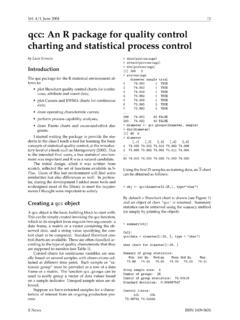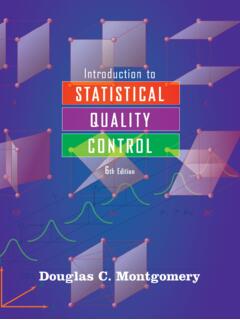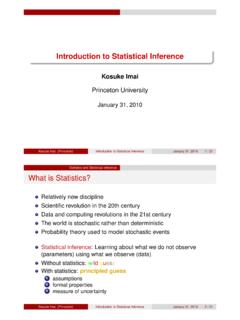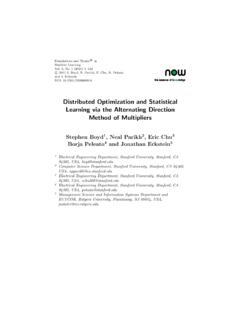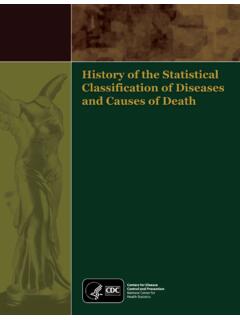Transcription of Introduction to Statistical Analysis - Flinders University
1 Pawel Skuza 2013 Introduction to Statistical AnalysisPawel SkuzaStatistical ConsultanteResearch@ Flinders / Central LibraryPawel Skuza 2013 Pawel Skuza 2013 Please note that the workshop is aimed to be a brief Introduction to the topic and this PowerPoint is primarily designed to support the flow of the lecture. It cannot be seen as either an exclusive or exhaustive resource on the Statistical concepts which are introduced in this course. You are encouraged to refer to peer-reviewed books or papers that are listed throughout the presentation. It is acknowledged that a number of slides have been adapted from presentations produced by the previous Statistical consultant (Kylie Lange) and a colleague with whom I worked with in the past (Dr Kelvin Gregory). Pawel Skuza 2013 Pawel Skuza 2013 Statistical Consulting or go to FlindersUniversity Website A-ZIndex S StatisticalConsultantIntroductory Level Introduction to IBM SPSS Introduction to Statistical Analysis IBM SPSS - Intermediate Level Understanding Your Data (Descriptive Statistics, Graphs and Custom Tables)
2 Correlation and Multiple Regression Logistic Regression and Survival Analysis Basic Statistical Techniques for Difference Questions Advanced Statistical Techniques for Difference Questions Longitudinal Data Analysis -Repeated Measures ANOVA Categorical Data Analysis IBM SPSS - Advanced Level Structural Equation Modelling using Amos Linear Mixed Models Longitudinal Data Analysis - Mixed and Latent Variable Growth Curve Models Scale Development Complex Sample Survey Design / ABS and FaHCSIA Confidentialised DatasetsPawel Skuza 2013 Pawel Skuza 2013 Introduction to Statistical you will learn A brief Introduction to a border framework of undertaking quantitatively orientated research Measures of central tendency and dispersion Standard errors and confidence intervals Introduction to hypothesis testing, including interpreting p-values Concepts of effect size and power How to select which Statistical method is appropriate for typical research questionsPawel Skuza 2013 Pawel Skuza 2013 What is Statistics ?
3 Sta tis tics(st -t s t ks) (used with a sing. verb)The mathematics of the collection, organization, and interpretation of numerical data, especially the Analysis of population characteristics by inference from (used with a pl. verb)Numerical data. President Lawrence Lowell wrote in 1909 that statistics, "like veal pies, are good if you know the person that made them, and are sure of the ingredients". Skuza 2013 Pawel Skuza 2013 Framework for conducting researchReproduced from Health Services Research Methods (Shi, 2008, p. 36)Pawel Skuza 2013 Pawel Skuza 2013 Population A Statistical population is a set of data corresponding to the entire collection of units about which information is sought Population data has variable information from every individual of interestSAMPLINGP awel Skuza 2013 Pawel Skuza 2013 The PopulationThe population must be defined explicitly before the study beginsand the research hypotheses/questions specify the population being by certain characteristics: Inclusion criteria Exclusion criteria Care must be taken not to generalize beyond the population.
4 SAMPLINGP awel Skuza 2013 Pawel Skuza 2013 Sample A sample from a Statistical populations is the subset of a data that are actually collected in the course of an investigation Sample data has variable information from only some of the individuals of interestSAMPLINGP awel Skuza 2013 Sampling Error The sampling error reflects the fact that the result we get from our sample is not going to be exactly equal to the result we would have got if we had been able to measure the entire population. And each possible sample we could take would give a different Skuza 2013 Pawel Skuza 2013 Samples and PopulationPopulation(Random) SampleStatistics summarize characteristicsParameters summarize characteristicsInferences from sample to populationSAMPLINGP awel Skuza 2013 Pawel Skuza 2013 Types of SamplesSAMPLINGP awel Skuza 2013 Pawel Skuza 2013 Non-probability / Convenience Samples Samples obtained by accidental or convenience samples are inappropriate for estimating population parameters -We have no way of knowing how representative the sample is of the population Types of unrepresentative samples Snowball samples Politically important cases Quota sample Extreme case samples Typical case samples Significance testing is not appropriate for non-random Skuza 2013 Pawel Skuza 2013 Selecting the sample The ultimate aim of statistics is to make inferences/generalise about the population.
5 Based on what we know about our sample. Validity of a Statistical inference depends on how representative the sample is of the population. Principles of sampling assume that samples are randomly obtained. Size of the sampling error is affected by the size of the sample. Increasing the sample size decreases the size of the sampling errorSAMPLINGP awel Skuza 2013 Pawel Skuza 2013 Simple Random Sampling All members of population have equal chance of selection Random numbers table; computer-generated Advantages Most basic kind of sampling Sampling error is easy to calculate Generally more representative Disadvantages Need a list of whole population Can be costly, timely, logistically difficultSAMPLINGP awel Skuza 2013 Stratified Random Sampling Population divided into two or more groups (strats)
6 According to some common characteristic Gender Ethic group Special populations Simple random sample within each strataSAMPLINGP awel Skuza 2013 Stratified Random Sampling Advantages Cheap to implement if strata are convenient groupings More precise results than simple random sampling Representativeness of stratifying variable Disadvantages Need information on stratifying variable Sampling frame needed for each strataSAMPLINGP awel Skuza 2013 Pawel Skuza 2013 Few definitions A parameter is a summary measure computed to describe a characteristic of the population Parameters describe the population Given Greek letters , , , , , A statistic is a summary measure computed to describe a characteristic of the sample Statistics describe the sample Given Roman letters a b c d eSAMPLINGP awel Skuza 2013 Pawel Skuza 2013 Framework for conducting researchReproduced from Health Services Research Methods (Shi, 2008, p.)
7 36)Pawel Skuza 2013 Pawel Skuza 2013 Term measurement refers to the procedure of attributing qualities or quantities to specific characteristics of objects, persons or events. Measurement is a key process in quantitative research, evaluation and in clinical practice. If the measurement procedures are inadequate its usefulness will be limited (Polgar & Thomas, 2008, p. 125)MEASUREMENTP awel Skuza 2013 Pawel Skuza 2013 Objective measurement involves the measurement of physical quantities and qualities using measurement equipmentSubjective measurement involves ratings or judgements by humans of quantities or qualities MEASUREMENTP awel Skuza 2013 Pawel Skuza 2013 Measurement tools and procedures ought to yield measurements that are reproducible, accurate, applicable to the measurement task in hand and practical or easy to use (Polgar & Thomas, 2008, p.
8 126)MEASUREMENTP awel Skuza 2013 Pawel Skuza 2013 Reliability is the property of reproducibility of the results of a measurement procedure or tool Validity is concerned with accuracy of the test procedureMEASUREMENTP awel Skuza 2013 Levels of Measurement and Measurement ScalesInterval DataOrdinal DataNominal DataHeight, Age, Weekly Food SpendingService quality rating, Student letter gradesMarital status, Type of car owned, Gender/SexRatio DataTemperature in Celsius, Standardized exam score Categories (no ordering or direction)Ordered Categories (rankings, order, or scaling) Differences between measurements but no true zeroDifferences between measurements, true zero existsEXAMPLES:MEASUREMENTP awel Skuza 2013 Pawel Skuza 2013 Framework for conducting researchReproduced from Health Services Research Methods (Shi, 2008, p.
9 36)Pawel Skuza 2013 Pawel Skuza 2013 Real World Data Data can be messy Incomplete data Missing attributes Missing attribute values Only aggregated data Inconsistent data Different coding Different naming conventions Impossible values Out-of-range values Noisy data Errors Outliers Inaccurate values! Need to pre-process the data before using for analysisDATA PROCESSINGP awel Skuza 2013 Pawel Skuza 2013 Getting to know your data Checking for errors Summary statistics Checking for Outliers Missing data Assessing Normality Graphs DATA PROCESSINGP awel Skuza 2013 Pawel Skuza 2013 Few definitions Variable Any characteristic or attribute of persons, objects, or events that can take on different numerical values Observation Is a record or notation made from observing a phenomenon Datum A single observation Data May be measurements or observations of a variable Case Typically a person being studiedDATA PROCESSINGP awel Skuza 2013 Pawel Skuza 2013 Common Data Entry Errors Wrong data but within range The marital status of married person is entered as a single Both single and married are legal This type of errors checked by using double entry method Wrong data and out of range If 1 stands for male and 2 stands for female, then the value of 3 represents erroneous data Frequency distribution procedures flagged these casesDATA PROCESSINGP awel Skuza 2013 Pawel Skuza 2013 Common Data Entry Errors False logic( Consistency )
10 A 25 years old respondent is reported as having experience of government service in 30 years. Missing data Missing data codes for items such as Not applicable and refuse to answer have not been pre coded in the questionnaire, even though they should have been Need to find these cases replace with the appropriate data code 8=refuse to answer 9=missingDATA PROCESSINGP awel Skuza 2013 Pawel Skuza 2013 Dealing with Missing Data Handling missing data Ignore record (not advisable) Fill in with attribute mean or median (not advisable) Fill in with most likely value based upon imputation process (various approaches available see below references for more information)DEDICATED WORKSHOP - PROCESSINGP awel Skuza 2013 Pawel Skuza 2013 Abraham, W. T., & Russell, D. W. (2004). Missing data: A review of current methods and applications in epidemiological research.
